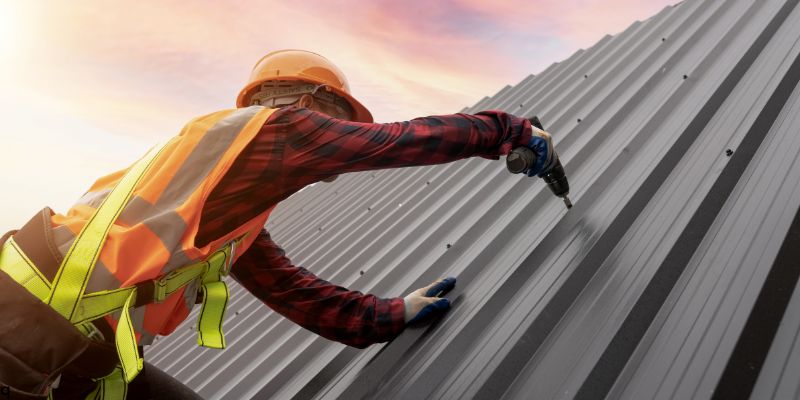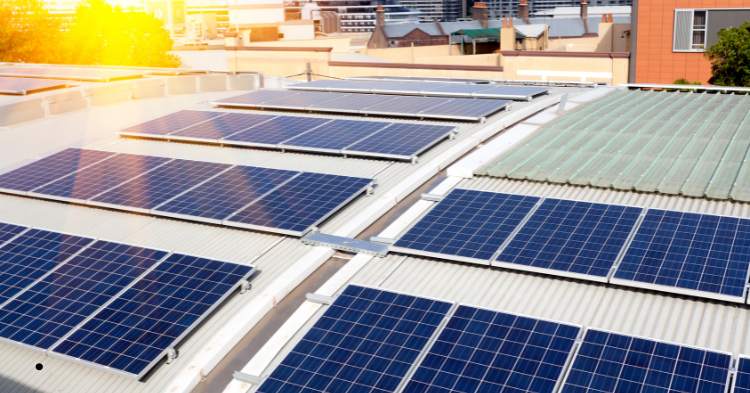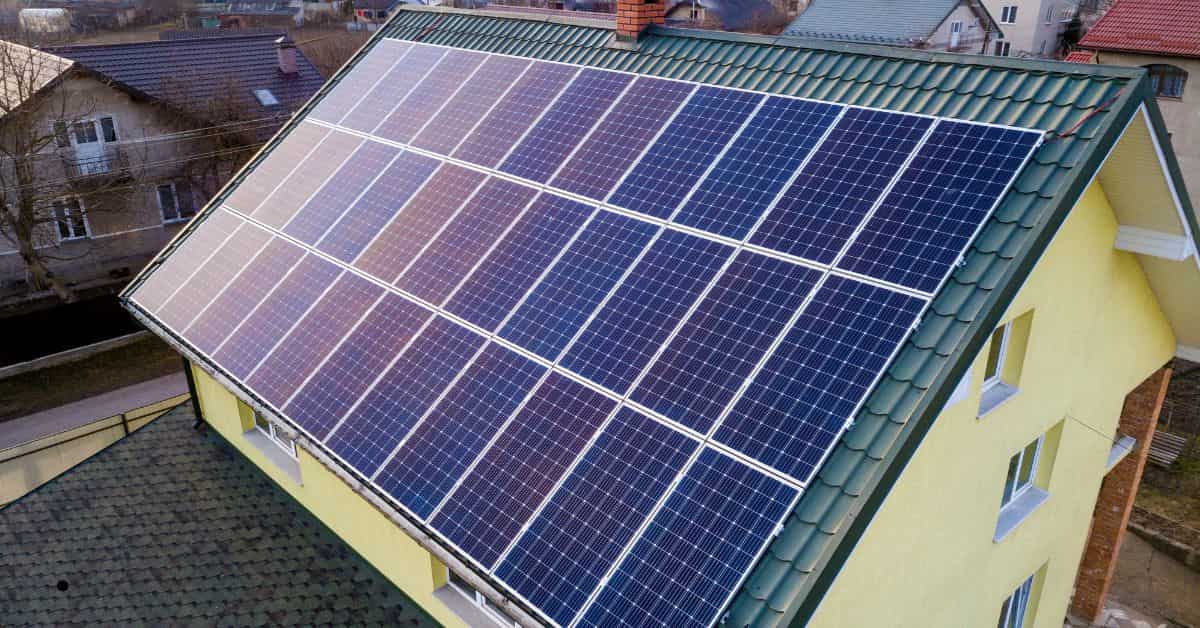Did you know solar panels on metal roofs can boost energy production by up to 30%? This is much better than with traditional roofing materials.
Metal roofs are ideal companions for solar energy systems. They often last as long as or longer than the 25–30 years typical for solar panels. This means you won’t have to remove and reinstall your system when replacing your roof. Additionally, the reflective properties of metal roofing help keep solar panels cooler, significantly improving their efficiency and output.
The installation process requires specific mounting solutions and techniques based on your metal roof type. If you have standing seam, corrugated, or trapezoidal metal panels, each type requires a unique method. This is important for keeping your roof strong and for the best solar performance.
This guide covers what homeowners should know about installing solar panels on metal roofs. We’ll discuss compatibility, mounting options, costs, and long-term benefits. In the end, you’ll learn how to make this eco-friendly upgrade, which cuts your carbon footprint and lowers your energy bills for years.
Why Metal Roofs Are Ideal for Solar Panels?

Durability and long lifespan
The extraordinary longevity of metal roofing creates a perfect partnership with solar technology. With good care, metal roofs last 40 to 70 years—much longer than the 25 to 30 years you can expect from solar panel systems. This long-lasting durability solves a common issue with other roofing materials: You won’t need to remove and reinstall solar panels when replacing the roof.
Traditional asphalt shingles usually need replacement every 12 to 20 years. This means you have to take down and reinstall solar arrays during that time, which can be costly and inconvenient. Metal roofs are robust against bad weather. They can handle winds up to 140 mph and have a Class 4 rating for hail resistance. This remarkable durability ensures your solar investment remains secure throughout its operational life. Homeowners and property owners interested in solar panels must check roof requirements.
Lightweight yet strong structure
Metal roofing materials are strong but surprisingly lightweight. This means they put less stress on your home’s foundation. This gives solar installations two benefits: a strong attachment point and less weight. Many homeowners pick metal roofs. They do this because metal roofs can hold solar panel systems well. They don’t need much extra support.
Standing seam metal roofs offer particular advantages, as they permit the installation of solar mounting systems without roof penetrations. Special clamps connect to the raised seams, keeping the roof strong and holding the panels in place. For corrugated or trapezoidal profiles, there are several mounting options. These options keep the structure strong and support solar arrays well.
Energy efficiency and cooling benefits
Metal roofing naturally reflects more sunlight than traditional roofing materials, reducing heat absorption. This reflectivity can slash cooling costs by up to 40%, even before solar panels are added.
Metal roofs cool down because they reflect sunlight well and release heat effectively. Standard black pigments reflect about 5% of solar energy. In contrast, special IR-reflective coatings can reflect 25–30%. Cool metal roofs can reduce air conditioning needs by 10–15%.
Solar panels on a metal roof can cool it down by shading the roof surface. This temperature drop boosts solar panel efficiency, and panels work better when it’s cooler. ENERGY STAR-qualified metal roofs can lower roof temperatures by as much as 50 degrees.
Types of Metal Roofs and Their Compatibility
Standing seam metal roofs
Standing seam metal roofs represent the gold standard for solar panel installation. These roofs feature vertical seams that run from the gutter to the ridge, creating raised channels between metal panels.
The primary advantage of standing seam roofs is their non-penetrative installation method. Special clamps attach directly to the raised seams, eliminating the need to drill holes through the roofing material. This clamping method keeps the roof intact, usually speeds up installation and cuts labor costs.
Each seam is unique. So, it’s important to use clamps made for your specific standing seam type. With proper installation, standing seam metal roofs can last an impressive 75+ years.
Corrugated metal roofs
Corrugated metal roofs have wavy ridges and grooves, making them a good choice for solar installation. They typically last 30+ years, making them sufficiently durable for solar panel systems.
Unlike standing seam designs, corrugated roofs usually require penetrating attachments. There are two primary mounting approaches for these roofs:
- Valley Installation: Place brackets in the valleys between ridges and screw them into the structural supports under the roof. This method provides excellent wind resistance but may pose waterproofing challenges.
- Hump installation – Mounting brackets attach to the raised ridges or “humps” of the corrugated pattern. This approach reduces leak risk but may offer less wind resistance.
Waterproofing is essential for corrugated roofs. Quality mounting systems use EPDM rubber gaskets or adhesive sealants. This keeps connections watertight.
Trapezoidal metal roofs
Trapezoidal metal roofs feature wider flat areas between raised ridges. These profiles require specialized mounting solutions tailored to their distinctive geometry.
Mounting options include:
- Aluminum profiles that attach to raised corrugations
- Short rail systems for minimal visual impact
- Thin sheet metal screws approved for building code compliance
The metal thickness is essential. Steel sheets should be at least 0.4mm thick, while aluminum should be 0.5mm (preferably 0.7mm) to support solar panel systems safely.
Mounting Systems for Different Roof Types

Clamp-based systems for standing seam
Standing seam roofs allow for zero-penetration systems. Clamps like those from S-5! Attach directly to raised seams without damaging the roof. These clamps use set screws that create a firm grip without compromising seam integrity.
There are two common types:
- Standard clamps for heavy-duty applications
- Mini clamps for lightweight solar panel systems
Clamp systems are designed to preserve roof warranties and speed up installation.
Bracket systems for corrugated roofs
Corrugated roofs usually need roof penetrations. Systems like CorruBracket use fasteners that go into the underlying structure, not just the metal sheet.
These brackets feature:
- Factory-applied sealants to prevent leaks
- Hidden sealant design to resist UV exposure
- Fasteners built to outlast the roof
Proper sealing and alignment with structural supports are critical for longevity.
Custom mounts for trapezoidal profiles
Trapezoidal roofs use mounting systems that match their shape. These include:
- Short rails (C24, C47) for easy handling
- Preassembled options with integrated cable management
- Light elevation features for improved panel efficiency
The mounting system must match your roof’s geometry and metal thickness for safety and performance.
Thin-film solar panel options
For low-profile needs, thin-film panels work well with standing seam metal roofs. These include:
- Peel-and-stick panels with adhesive backing
- BIPV systems integrated directly onto the roof surface
- Flexible designs with bypass diodes for partial shading
These panels are lightweight and sleek, though they offer lower efficiency per square foot than traditional crystalline panels.
Installation Considerations and Best Practices
Avoiding roof penetrations where possible
Clamp-on systems are ideal for preserving roof integrity. Avoid placing fasteners in water channels when drilling is necessary (as in corrugated and trapezoidal profiles). Thin-film panels offer a zero-penetration option for compatible surfaces. You must check essential guidelines before installing solar panels on the roof.
Ensuring waterproofing and seal integrity
For weatherproofing, use high-quality, non-curing butyl sealants and rubber gaskets. Proper torque on fasteners and multi-layer sealing ensure long-lasting protection.
Weight load and structural inspection
Before installation, a structural engineer should evaluate your roof. Solar panels typically weigh around 22kg per panel. Ensure your roof can handle static and dynamic loads (e.g., snow and wind). Reinforcement may be necessary for older roofs.
Installer safety and fall protection
OSHA requires fall protection for work over 6 feet high. Standing seam roofs need clamp-on anchors, while corrugated roofs require anchors that don’t penetrate seams. Your system design should include maintenance pathways and secure access points.
Cost, Incentives, and Long-Term Value
Federal solar tax credit
Homeowners can claim 30% of installation costs through 2032. This includes panels, labor, and batteries. The credit begins to decline in 2033. There’s no dollar limit, and unused portions can roll over to future tax years.
State-level rebates and incentives
Depending on your location, you may qualify for:
- Property tax exemptions
- Direct rebates
- SRECs (Solar Renewable Energy Credits)
- Net metering programs
Utility companies may also offer bonus rebates or incentives for installing solar.
Return on investment over time
Solar panel payback typically takes 6–10 years. After this, you enjoy nearly free electricity. A 6kW system costs around $20,520 before incentives, but rebates significantly reduce this. Combined with long-lasting metal roofing, the return improves further.
Impact on home resale value
Homes with solar systems sell for about 4.1% more. Buyers value energy savings and reduced utility bills. Each $1 saved annually on energy bills adds roughly $20 to home value. Solar also attracts eco-conscious buyers looking for energy independence.
Last, if you want to remove solar panels from your roof or uninstall solar panels, you must always take care.
Conclusion
Solar panels and metal roofs are a match made in energy-efficiency heaven. Metal roofs offer great durability, a strong structure, and cooling benefits, which improve solar performance.
Pick the correct mounting method—clamp-based, bracketed, or thin-film. This choice helps protect your roof and boosts your return. And with federal and state incentives available, going solar is more affordable than ever.
Investing in solar on a metal roof allows you to choose decades of clean energy, lower bills, and a smarter, greener home. Long-term savings, tax credits, and boosted home value easily offset the upfront investment.
Before you begin, consult a qualified installer to assess your roof type, structural load, and energy goals. With the proper guidance, installing solar panels on a metal roof becomes one of the most rewarding upgrades you can make to your home.


